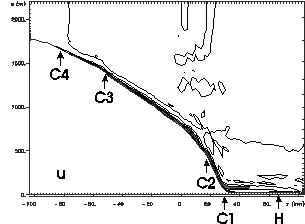 In this project a state-of-the-art numerical weather prediction model (RAMS) will be used to carry out simulations of the interaction between katabatic flows and the atmospheric boundary layer over the sea ice zone. A unique set of year-round near-surface katabatic wind profiles from Coats Land, Antarctica and Halley Research Station that was gathered during 2002 & 2003 will be used as validation of the numerical simulations over the continent. What sparse atmospheric observations are available over the coastal sea-ice zone will be used as validation over the ocean. The RAMS model has already successfully been used to simulate “idealised” katabatic flows over Coats Land (Renfrew 2004 – see Figure: a simulation of downslope wind field after 24 h over Coats Land, the Brunt Ice Shelf and the adjoining sea ice zone). The first aim of this project will be the simulation of a number of “case studies” where specific observational data are available. Once thoroughly tested, the model domain will be relocated to other parts of the continent where katabatic flow/marine boundary layer interactions are thought to be more important. The interaction will be examined through a series of sensitivity experiments, for example, changing the continental slope (and so the strength of the downslope winds); changing the background atmospheric forcing; changing the model’s sea-ice distribution; and changing parameterisations important to the surface fluxes in the model. Generic conclusions drawn from the atmospheric boundary-layer modelling work will be used to assess the importance of katabatic flows in the exchange of heat, moisture and momentum in the sea-ice zone.
In this project a state-of-the-art numerical weather prediction model (RAMS) will be used to carry out simulations of the interaction between katabatic flows and the atmospheric boundary layer over the sea ice zone. A unique set of year-round near-surface katabatic wind profiles from Coats Land, Antarctica and Halley Research Station that was gathered during 2002 & 2003 will be used as validation of the numerical simulations over the continent. What sparse atmospheric observations are available over the coastal sea-ice zone will be used as validation over the ocean. The RAMS model has already successfully been used to simulate “idealised” katabatic flows over Coats Land (Renfrew 2004 – see Figure: a simulation of downslope wind field after 24 h over Coats Land, the Brunt Ice Shelf and the adjoining sea ice zone). The first aim of this project will be the simulation of a number of “case studies” where specific observational data are available. Once thoroughly tested, the model domain will be relocated to other parts of the continent where katabatic flow/marine boundary layer interactions are thought to be more important. The interaction will be examined through a series of sensitivity experiments, for example, changing the continental slope (and so the strength of the downslope winds); changing the background atmospheric forcing; changing the model’s sea-ice distribution; and changing parameterisations important to the surface fluxes in the model. Generic conclusions drawn from the atmospheric boundary-layer modelling work will be used to assess the importance of katabatic flows in the exchange of heat, moisture and momentum in the sea-ice zone.Renfrew, I. A., 2004: The dynamics of idealized katabatic flow over a moderate slope and ice shelf, Quart. J. Roy. Meteor. Soc., 130, 1023-1045.